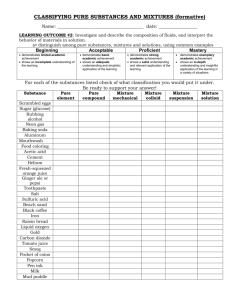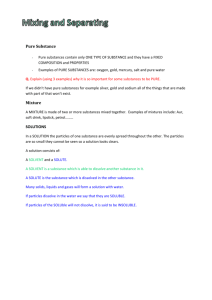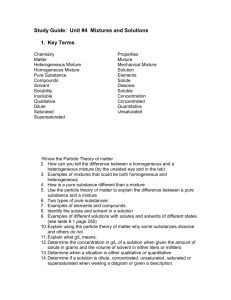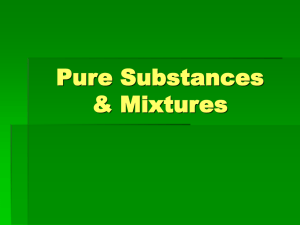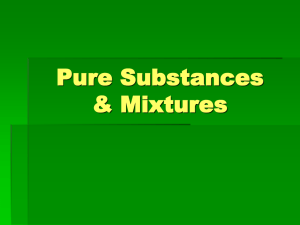9.9 Pure substances and mixtures
advertisement
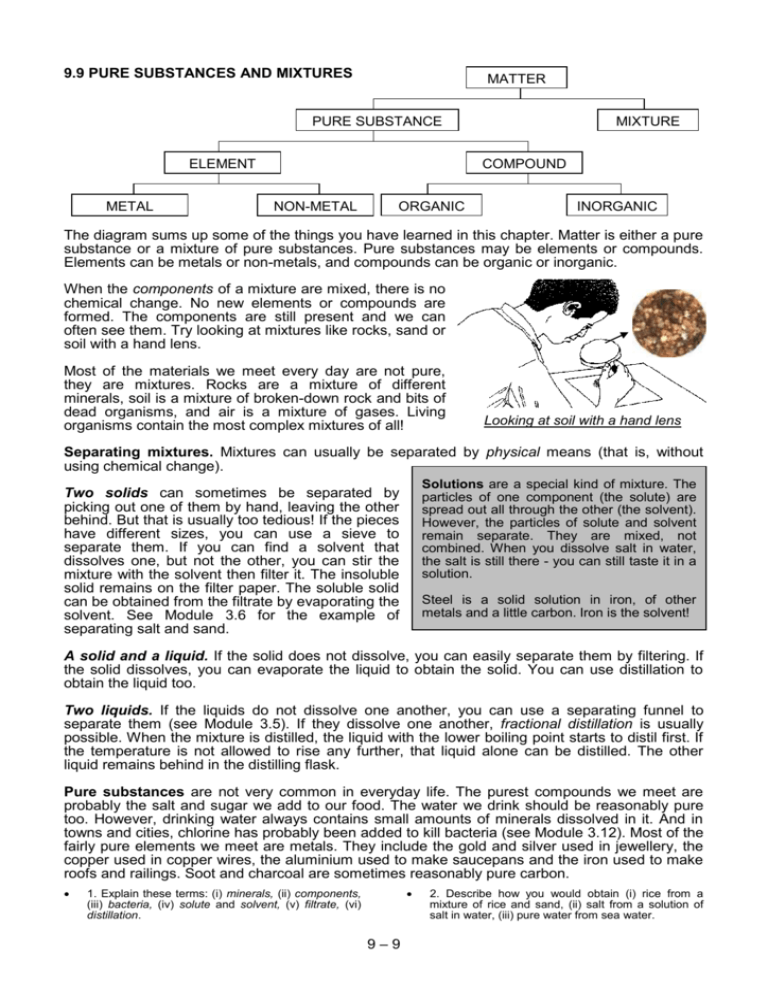
9.9 PURE SUBSTANCES AND MIXTURES MATTER PURE SUBSTANCE ELEMENT METAL MIXTURE COMPOUND NON-METAL ORGANIC INORGANIC The diagram sums up some of the things you have learned in this chapter. Matter is either a pure substance or a mixture of pure substances. Pure substances may be elements or compounds. Elements can be metals or non-metals, and compounds can be organic or inorganic. When the components of a mixture are mixed, there is no chemical change. No new elements or compounds are formed. The components are still present and we can often see them. Try looking at mixtures like rocks, sand or soil with a hand lens. Most of the materials we meet every day are not pure, they are mixtures. Rocks are a mixture of different minerals, soil is a mixture of broken-down rock and bits of dead organisms, and air is a mixture of gases. Living organisms contain the most complex mixtures of all! Looking at soil with a hand lens Separating mixtures. Mixtures can usually be separated by physical means (that is, without using chemical change). Solutions are a special kind of mixture. The particles of one component (the solute) are spread out all through the other (the solvent). However, the particles of solute and solvent remain separate. They are mixed, not combined. When you dissolve salt in water, the salt is still there - you can still taste it in a solution. Two solids can sometimes be separated by picking out one of them by hand, leaving the other behind. But that is usually too tedious! If the pieces have different sizes, you can use a sieve to separate them. If you can find a solvent that dissolves one, but not the other, you can stir the mixture with the solvent then filter it. The insoluble solid remains on the filter paper. The soluble solid can be obtained from the filtrate by evaporating the solvent. See Module 3.6 for the example of separating salt and sand. Steel is a solid solution in iron, of other metals and a little carbon. Iron is the solvent! A solid and a liquid. If the solid does not dissolve, you can easily separate them by filtering. If the solid dissolves, you can evaporate the liquid to obtain the solid. You can use distillation to obtain the liquid too. Two liquids. If the liquids do not dissolve one another, you can use a separating funnel to separate them (see Module 3.5). If they dissolve one another, fractional distillation is usually possible. When the mixture is distilled, the liquid with the lower boiling point starts to distil first. If the temperature is not allowed to rise any further, that liquid alone can be distilled. The other liquid remains behind in the distilling flask. Pure substances are not very common in everyday life. The purest compounds we meet are probably the salt and sugar we add to our food. The water we drink should be reasonably pure too. However, drinking water always contains small amounts of minerals dissolved in it. And in towns and cities, chlorine has probably been added to kill bacteria (see Module 3.12). Most of the fairly pure elements we meet are metals. They include the gold and silver used in jewellery, the copper used in copper wires, the aluminium used to make saucepans and the iron used to make roofs and railings. Soot and charcoal are sometimes reasonably pure carbon. 1. Explain these terms: (i) minerals, (ii) components, (iii) bacteria, (iv) solute and solvent, (v) filtrate, (vi) distillation. 9–9 2. Describe how you would obtain (i) rice from a mixture of rice and sand, (ii) salt from a solution of salt in water, (iii) pure water from sea water.


